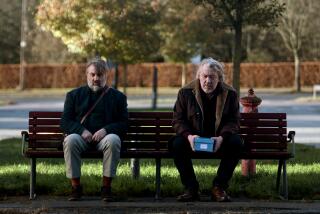‘Blade Runner 2049’ production designer finds the beauty in the bleak
Oscar-winning production designer Dennis Gassner is the veteran of nearly 30 films by many of the most respected directors in the world — the Coen brothers, Francis Ford Coppola, Peter Weir, Sam Mendes and Stephen Frears among them. Four decades into a film career, Gassner has a virtually unrivaled longevity and quality of work.
He’s been nominated for an Oscar five times, winning once. And now with his much-heralded work on the expansive “Blade Runner 2049,” that tally is bound to grow. Consider that Times film critic Kenneth Turan cited the work of Gassner and cinematographer Roger Deakins in his review, noting, “This film puts you firmly, brilliantly, unassailably in another world of its own devising, and that is no small thing.”
His 1920s Whitley Heights home is a veritable production design created from artifacts from some of his sets, including a Moroccan rug from “Spectre” and a faux Modigliani from the same film. The original Art Deco dining table and chairs? Plucked from his Oscar-winning design for “Bugsy.”
WATCH: Video Q&As from this season’s hottest contenders »
“It’s my history,” the youthful 68-year-old production designer explains; “a museum of cinematic memories, of things from my life, my travels.”
Have you really designed 30 films in 40 years? That sounds pretty breakneck.
Something like that. I’m so grateful to have worked with creatives like the Coens, Sam Mendes, Stephen Frears. That list of who I’m interested in working with, though, is getting very small. But there are people coming up like [“Blade Runner 2049” director Denis Villeneuve] who are passionate — he’s an amazing guy.
What jumping-off point did he give you to visualize the set? Reviewers commented on the pollution, the scale of it, the fortress-like buildings, the hologram billboards.
In the film, 2049 is even more extreme than what was in the original, almost a doubly dystopian world, set 30 years later. When we started, I asked for one word from Denis — to find an essence, a touchstone. “Brutality” was his word. Everything in this world has changed for the worse: It’s even more apocalyptic. Have we gone through the Ice Age, global warming? We don’t know exactly, but Denis says it doesn’t matter. The sea’s encroaching, it’s raining all the time. But I hope it’s rather beautifully bleak.
Why was a futuristic film like “Blade Runner 2049” mostly built and shot “in camera” — with a lot less CGI and green screen than expected?
I refused to be influenced by all the tech-heavy sci-fi and futuristic films we’ve seen since — sure, we could have used computers, which they didn’t have for the original in 1982. We could have CGI’d the hell out of this film — but that was not our precedent. It’s not “Star Wars.”
We could have CGI’d the hell out of this film — but that was not our precedent. It’s not ‘Star Wars.’
— Dennis Gassner
The film paints all this man-made devastation in tonal shades of oranges and yellows and sand. Why?
Roger and I needed to create an uneasy mood, an emotion; orange tones are a metaphor we’ve used before — for fire, heat. And yellow’s envy in the gestalt. And we used it for continuity. The audience is now so educated they understand continuity — and tweet to my office: “What were you thinking about in this scene?” I can’t be off my game — because I don’t want those tweets!
You’ve said that emotion’s the through line of your set designs. How did that effect this fairly cold film? Many critics have commented on how oversized the sets are.
That was very purposeful. A big part of what I do is find the story’s emotional texture. That allows the actors to come into a space, and go, “Wow.” That’s all I’m listening for. Ever. The big “wow.” On “Blade Runner,” when the actors first walked onto the set, I got a very big ‘wow.’ That’s all I want from the audience too. In this case, devastation of a big city leaves wide open ruins.
You spent over a year on this film — on environmental and emotional dystopia. Did it feel particularly bleak?
You can get a bit depressed, working on a dark film. I’ve done many. The way I counteract that emotionally is to meditate, swim, take road trips and spend as much time as I can in my house in Hawaii.
More to Read
From the Oscars to the Emmys.
Get the Envelope newsletter for exclusive awards season coverage, behind-the-scenes stories from the Envelope podcast and columnist Glenn Whipp’s must-read analysis.
You may occasionally receive promotional content from the Los Angeles Times.






